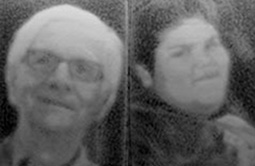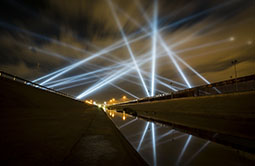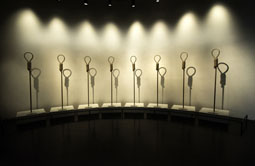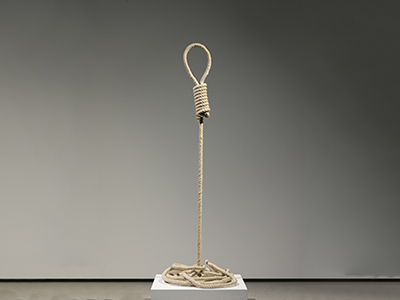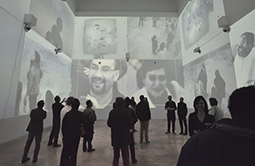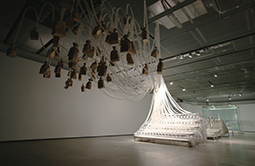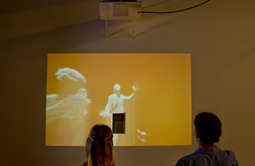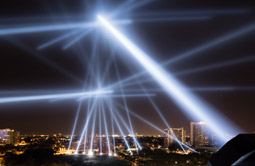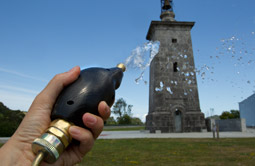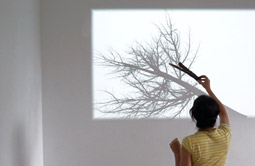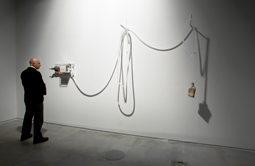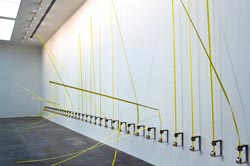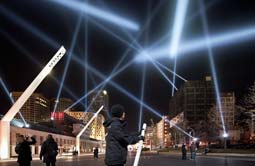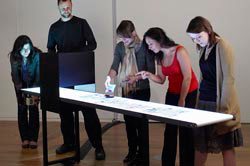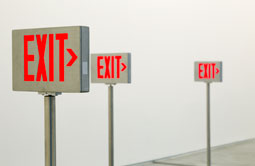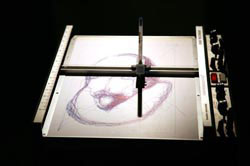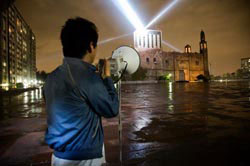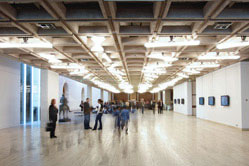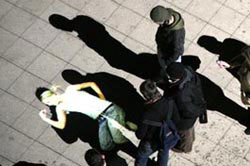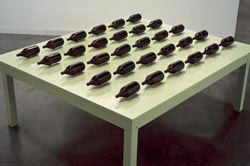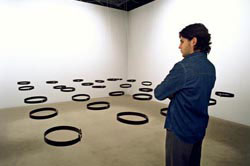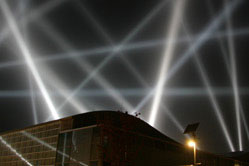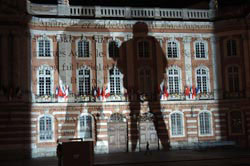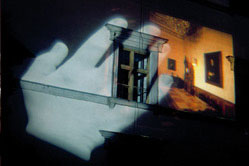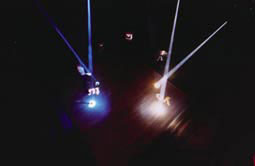A Crack in the Hourglass
2020
“A Crack in the Hourglass” is a transitory “anti-monument” in response to the pandemic and the ways it has halted public rituals of mourning. In this participatory artwork, a modified robotic plotter deposits grains of hourglass sand onto a black surface to recreate the images of those lost due to COVID-19.
View details.
View details.
Border Tuner / Sintonizador Fronterizo
Relational Architecture 23, 2019
"Border Tuner" is a large-scale, participatory art installation designed to interconnect the cities of El Paso, Texas, and Ciudad Juárez, Chihuahua. Powerful searchlights make “bridges of light” that open live sound channels for communication across the US-Mexico border. The piece creates a fluid canopy of light that can be modified by visitors to six interactive stations, three placed in El Paso and three in Juárez.
View details.
View details.
Metrónomos
2018
“Metrónomos” is a kinetic installation consisting of eight inverted nooses, which move slightly according to the rhythm of various global statistics on human rights violations. Commissioned for Mexico’s Memory and Tolerance Museum, the sculptures are presented on pedestals, arranged in a semi-circle. The frequency in which each noose, or metronome, sways depends on the statistic that each one represents: the number of forced displacements or deportations, acts of torture, cruelty and sexual violence, crimes against the environment, among others. Each noose contains the heartbreaking rhythm of a different scale, in order to materialize, symbolically, the frequency in which human rights are violated. Together, they create a chorus of sculptures activated by statistical data.
View details.
View details.
Sway
2016
"Sway" is a kinetic sculpture that responds to data; it is a computer-controlled metronome that oscillates to the rhythm of a specific statistic. The rope was braided onto a thin vertical steel rod to make it stand upright and the floor rope acts as a free-standing base. The piece stands on a wooden plinth which contains a small motor and an electrical circuit that makes the noose sway and pendulate almost imperceptibly from time to time. The sway adds to the trompe l’oeil effect of the rope hanging upside-down. The collector or curator may choose the frequency with which the rope sways, with the default value being around once every 40 to 60 seconds, which represents therate of homicides in the World.
View details.
View details.
Zoom Pavilion
2015
“Zoom Pavilion” is an interactive installation that consists of immersive projection on three walls, fed by 12 computerized surveillance systems trained on the public. The piece uses face recognition algorithms to detect the presence of participants and record their spatial relationship within the exhibition space. Independent robotic cameras zoom in to amplify the images of the public with up to 35x magnification: the zooming sequences are disorienting as they change the entire image "landscape" from easily recognizable wide shots of the crowd to abstract close-ups. Zoom Pavilion marks the first collaboration between artists Rafael Lozano-Hemmer and Krzysztof Wodiczko.
View details.
View details.
Vicious Circular Breathing
2013
“Vicious Circular Breathing” is a hermetically-sealed apparatus that invites the public to breathe the air that was previously breathed by participants before them. The installation consists of a glass room with double sliding doors, two emergency exits, carbon dioxide and oxygen sensors, a set of motorized bellows, an electromagnetic valve system, and 61 brown paper bags hanging from respiration tubes. In the piece, visitors’ breath is kept circulating and made visible by automatically inflating and deflating the brown paper bags around 10,000 times a day, the normal respiratory frequency for an adult at rest. The piece includes warnings for asphyxiation, contagion and panic, and produces a faint mechanical sound, a quiet whir from the air flow and louder crackles from the crumpling bags.
View details.
View details.
First Surface
Shadow Object 3, 2012
“First Surface” (Shadow Object 3) is an artwork consisting of two front surface mirrors that are suspended from a thread and move with the air flow and with a small motor. Projected on the wall behind the mirrors is a real-time virtual representation of the public as seen from the perspective of the mirrors. The public is represented as patterned 3D silhouettes anchored in a reference prism that rotates with the mirrors. The piece is an attempt to construct an artificial perspective on the reflected subject.
View details.
View details.
Semioptics for Spinoza
Shadow Object 4, 2012
“Semioptics for Spinoza” (Shadow Object 4) is a plano-convex lens is suspended from a thread and moves with the airflow and with a small motor. Projected on the wall behind the lens is a set of artificial lens flares generated by equations that take into account the orientation of the lens in relation to the viewing public. The project generates fake light beams that go through the real lens: the lens then diffracts and scatters the fake light creating light source aberrations, directional haze and chromatic distortion.
View details.
View details.
Open Air
Relational Architecture 19, 2012
“Open Air” (Relational Architecture 19) was an interactive artwork that allowed participants’ voices to transform the sky over Philadelphia. Using a website or a free iPhone app participants could record a voice message and listen to and rate other entries. The messages were played-back over the Benjamin Franklin Parkway using 24 powerful robotic searchlights that reacted, both in brightness and position, to the voice’s frequency and volume as well as to the phone's GPS location.
View details.
View details.
Pulse Drip
2012
“Pulse Drip” is an interactive installation originally developed for Urdaibai Art 2012 in which the public can water the lawn at the Torre de Madariaga using a water hose with a heart rate sensor built-in.
View details.
View details.
Bifurcation
Shadow Object 2, 2012
“ Bifurcation” (Shadow Object 2) is small Y-shaped branch, similar to a divining rod, which is suspended from a thread and moves with the air flow and with a small motor. Projected on the wall behind the branch is its shadow, only you can see the entire tree from where the branch came. The branch and the tree shadow are always oriented in the same way.
View details.
View details.
Last Breath
2012
“Last Breath” is an installation designed to store and circulate the breath of a person forever. The piece consists of a small brown paper bag which inflates and deflates automatically thanks to motorized bellows similar to those found in artificial respirators in hospitals. The apparatus hangs on a wall and is activated 10,000 times a day, the typical respiratory frequency for an adult at rest, including 158 sighs.
View details.
View details.
Tape Recorders
Subsculpture 14, 2011
In “Tape Recorders” (Subsculpture 14), rows of motorised measuring tapes record the amount of time that visitors stay in the installation. As a computerised tracking system detects the presence of a person, the closest measuring tape starts to project upwards. When the tape reaches around 3 meters high it crashes and recoils back. Each hour, the system prints the total number of minutes spent by the sum of all visitors.
View details.
View details.
Articulated Intersect
Relational Architecture 18, 2011
"Articulated Intersect" (Relational Architecture 18) is a large-scale installation that produces an interactive canopy of light that can be modified by the public using six large lever-controllers that protrude from the ground. As a participant points one of these levers three powerful robotic searchlights automatically intersect in the sky to create an apex at that location. The participant may direct the apex anywhere over the city in real-time, creating an animated tetrahedron inspired by the work of Richard Buckminster Fuller.
View details.
View details.
Please Empty Your Pockets
Subsculpture 12, 2010
“Please Empty your Pockets” (Subsculpture 12) is an installation that consists of a conveyor belt with a scanner that records and accumulates everything that passes under it. The public may place any small object on the conveyor belt: once it passes under the scanner, the object reappears on the other side beside projected objects from the memory of the installation. As a real item is removed from the conveyor belt, it leaves behind a projected image of itself, which is then used to accompany future objects. The piece remembers up to 600,000 objects which are displayed beside new ones that are added to the installation.
View details.
View details.
Cardinal Directions
Subsculpture 11, 2010
"Cardinal Directions", is a kinetic sculpture which consists of a surveillance monitor that displays an extract of Vicente Huidobro´s poem "Altazor" (1919-1931). Refering to the geography of his native Chile, Huidobro wrote "The four cardinal directions are three: North and South". When a presence is detected by infrared sensors, the monitor starts to rotate. As the poem is "geolocated" it always aligns itself to the cardinal points, and the public must walk around the piece in order to read it, like a kind of periscope.
View details.
View details.
Reference Flow
2009
"Reference Flow" is an interactive installation where a number of illuminated EXIT signs, supported by motorized stanchions, rotate automatically as people walk past them so that they always signal escape routes to the left. If several people stroll through the signs they get disoriented as they try their best to confront each person with his or her left.
View details.
View details.
Seismoscopes
2009
The series "Seismoscopes" consists of devices that detect vibration around them, from footsteps to earthquakes, and record this vibration on paper using an automated XY-plotter. As each Seismoscope registers any seismic wave it is programmed to draw an illustration of a single Skeptical philosopher, over and over again.
View details.
View details.
Voz Alta
Relational Architecture 15, 2008
"Voz Alta" (Loud Voice)(Relational Architecture 15) is a memorial commissioned for the 40th anniversary of the student massacre in Tlatelolco. Participants who speak into a megaphone automatically control the brightness of four searchlights that relay their voice over Mexico City as quiet light flashes; tuning into 96.1FM radio allows people anywhere in the city to listen in live to what the lights are saying.
View details.
View details.
Apostasis
2008
An interactive installation featuring powerful robotic searchlights that create static columns of light in a dark room. When someone tries to walk into a light beam, a computer automatically moves the searchlight so that the beam is pointed somewhere else on the room. A video tracking system observes the room and makes sure that the lights are always illuminating empty spaces where there is no one. People may continually attempt to enter the spotlight but the system will adapt to ensure this can never be achieved.
View details.
View details.
Wavefunction
Subsculpture 9, 2007
"Wavefunction" (Subsculpture 9) is a kinetic sculpture comprised of fifty to one hundred Charles and Ray Eames moulded chairs (designed in 1948) and placed in a regular array of rows, facing the entrance to the exhibition space. When someone approaches the work, a computerised surveillance system detects their presence and the closest chairs automatically begin to lift off the ground, creating the crest of a wave that then spreads over the whole room.
View details.
View details.
Homographies
Subsculpture 7, 2006
"Homographies" (Subsculpture 7) is a large-scale interactive installation featuring a turbulent light array that responds to the movement of the public using a surveillance tracking system. The installation consists of white fluorescent light tubes hung from robotic fixtures on the ceiling of the exhibition space, equally spaced. Each light tube rotates slowly using a computerized stepper motor and create labyrinthine patterns of light that make "paths" or "corridors" between people. All lights are always on and typically constitute the only lighting in the exhibition hall, except for the natural light that spills into the space.
View details.
View details.
Under Scan
Relational Architecture 11, 2005
"Under Scan" (Relational Architecture 11) is a public art installation based on self-representation. Thousands of "video-portraits" taken in Derby, Leicester, Lincoln, Northampton and Nottingham are projected onto the ground; at first, the portraits are not visible because the space is flooded by white light coming from a high-powered projector. As people walk around the area, their shadows are cast on the ground, revealing the video-portraits in short sequences.
View details.
View details.
Synaptic Caguamas
Subsculpture 4, 2004
"Synaptic Caguamas" (Subsculpture 4) is a kinetic sculpture consisting of a motorized Mexican "cantina" bar table with 30 "Caguama"-sized beer bottles (1-litre each). The bottles spin on the table with patterns generated by cellular automata algorithms that simulate the neuronal connections in the brain. Every few minutes the bottles are reset automatically and seeded with new initial conditions for the algorithm, so that the movement patterns are never repeated.
View details.
View details.
Standards and Double Standards
Subsculpture 3, 2004
"Standards and Double Standards" (Subsculpture 3) is an interactive installation that consists of 10 to 100 fastened belts that are suspended at waist height from stepper motors on the ceiling of the exhibition room. Controlled by a computerized tracking system, the belts rotate automatically to follow the public, turning their buckles slowly to face passers-by. When several people are in the room their presence affects the entire group of belts, creating chaotic patterns of interference. Non-linear behaviours emerge such as turbulence, eddies and relatively quiet regions.
View details.
View details.
Amodal Suspension
Relational Architecture 8, 2003
“Amodal Suspension" (Relational Architecture 8) is a large-scale interactive installation in which people send short text messages to each other using a cell phone or web browser. However, rather than being sent directly, the messages are encoded as unique sequences of flashes with twenty robotically-controlled searchlights, not unlike the patterns that make up Morse code. Messages "bounce" around from searchlight to searchlight, turning the sky into a giant switchboard.
View details.
View details.
Two Origins
Relational Architecture 7, 2002
“Two Origins” (Relational Architecture 7) is an intervention in which the emblematic Place du Capitole in Toulouse was transformed by a projection of The Book of Two Origins, a 13th-century heretical manuscript compiling the theological beliefs of the dualist cathars. Once a vibrant community in several regions of Europe, the believers in the two origins of the Universe were virtually annihilated by the brutal crusades that gave birth to the Inquisition and France's expansion. The texts are illegible since they are projected overlapping each other on the same façade from two distant projectors; only when passers-by block one text with their bodies is it possible to read the other text inside their shadow.
View details.
View details.
Vectorial Elevation
Relational Architecture 4, 1999
"Vectorial Elevation" (Relational Architecture 4) is an interactive art project originally designed to celebrate the arrival of the year 2000 in Mexico City's Zócalo Square. The website www.alzado.net enabled any Internet user to design light sculptures over the city's historic centre, with eighteen searchlights positioned around the square. These searchlights, whose powerful beams could be seen within a 15 kilometers radius, were controlled by an online 3D simulation program and visualised by digital cameras. A personalised webpage was produced for every participant with images of their design and information such as their name, dedication, place of access and comments.
View details.
View details.
Displaced Emperors
Relational Architecture 2, 1997
"Displaced Emperors" (Relational Architecture 2) was an interactive installation that used an "architact" —architecture meets haptics— interface to transform the facade of the Habsburg Castle in Linz, Austria. Wireless 3D sensors calculated where participants pointed to on the façade and a large animated projection of a hand was projected at that location. As people on the street "caressed" the building, they could reveal the interiors of the Habsburg residence in Mexico City, Castillo de Chapultepec.
View details.
View details.
The Trace
1995
"The Trace" is a telepresence installation that invites two participants in remote sites to share the same telematic space. The piece consists of light vectors, sounds and graphics that respond to the movement of the participants. Two interactive stations are needed for the piece; these are interconnected with a normal ISDN digital line so they can be in the same exhibition hall, on either side of a city or in different cities.
View details.
View details.
